Analysis of Communication and Medication Safety in Nursing Practice
VerifiedAdded on 2022/09/28
|7
|1633
|31
Report
AI Summary
This report critically analyzes communication and medication safety within the context of nursing practice. It begins by highlighting the importance of effective communication among healthcare teams, emphasizing its role in ensuring patient safety and quality care. The report examines a case scenario where communication breakdowns and medication errors occurred, identifying failures in verbal and written communication, adherence to protocols, and clinical governance. The analysis applies relevant National Safety and Quality Health Standards and practice guidelines to identify areas for improvement. Recommendations are provided for registered nurses, including the implementation of clear communication strategies, adherence to medication administration protocols, and the adoption of clinical governance measures such as QADDS monitoring systems. The report underscores the nurse's responsibility in advocating for patient safety and provides a reflective statement on the learning gained from the analysis.
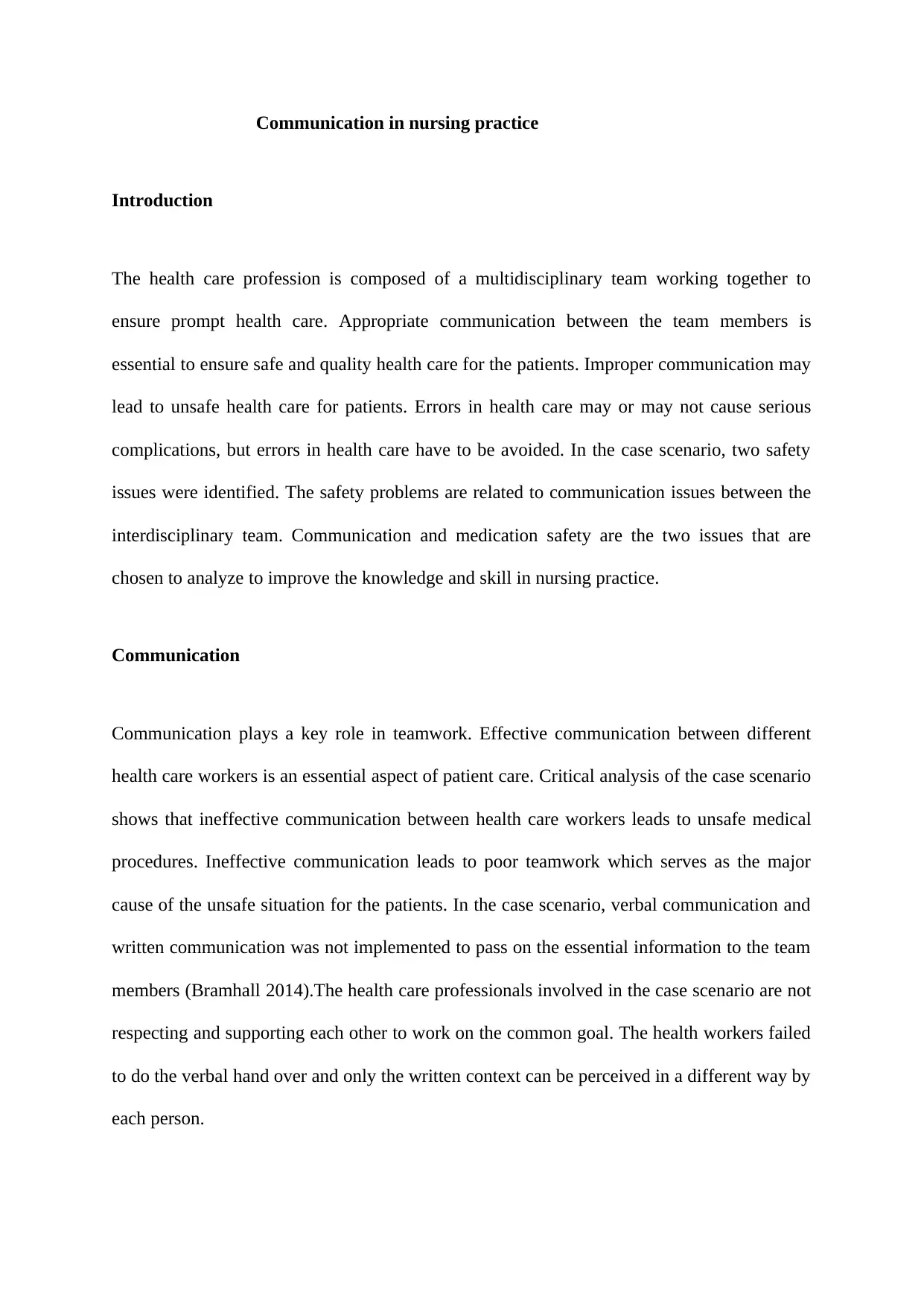
Communication in nursing practice
Introduction
The health care profession is composed of a multidisciplinary team working together to
ensure prompt health care. Appropriate communication between the team members is
essential to ensure safe and quality health care for the patients. Improper communication may
lead to unsafe health care for patients. Errors in health care may or may not cause serious
complications, but errors in health care have to be avoided. In the case scenario, two safety
issues were identified. The safety problems are related to communication issues between the
interdisciplinary team. Communication and medication safety are the two issues that are
chosen to analyze to improve the knowledge and skill in nursing practice.
Communication
Communication plays a key role in teamwork. Effective communication between different
health care workers is an essential aspect of patient care. Critical analysis of the case scenario
shows that ineffective communication between health care workers leads to unsafe medical
procedures. Ineffective communication leads to poor teamwork which serves as the major
cause of the unsafe situation for the patients. In the case scenario, verbal communication and
written communication was not implemented to pass on the essential information to the team
members (Bramhall 2014).The health care professionals involved in the case scenario are not
respecting and supporting each other to work on the common goal. The health workers failed
to do the verbal hand over and only the written context can be perceived in a different way by
each person.
Introduction
The health care profession is composed of a multidisciplinary team working together to
ensure prompt health care. Appropriate communication between the team members is
essential to ensure safe and quality health care for the patients. Improper communication may
lead to unsafe health care for patients. Errors in health care may or may not cause serious
complications, but errors in health care have to be avoided. In the case scenario, two safety
issues were identified. The safety problems are related to communication issues between the
interdisciplinary team. Communication and medication safety are the two issues that are
chosen to analyze to improve the knowledge and skill in nursing practice.
Communication
Communication plays a key role in teamwork. Effective communication between different
health care workers is an essential aspect of patient care. Critical analysis of the case scenario
shows that ineffective communication between health care workers leads to unsafe medical
procedures. Ineffective communication leads to poor teamwork which serves as the major
cause of the unsafe situation for the patients. In the case scenario, verbal communication and
written communication was not implemented to pass on the essential information to the team
members (Bramhall 2014).The health care professionals involved in the case scenario are not
respecting and supporting each other to work on the common goal. The health workers failed
to do the verbal hand over and only the written context can be perceived in a different way by
each person.
Paraphrase This Document
Need a fresh take? Get an instant paraphrase of this document with our AI Paraphraser
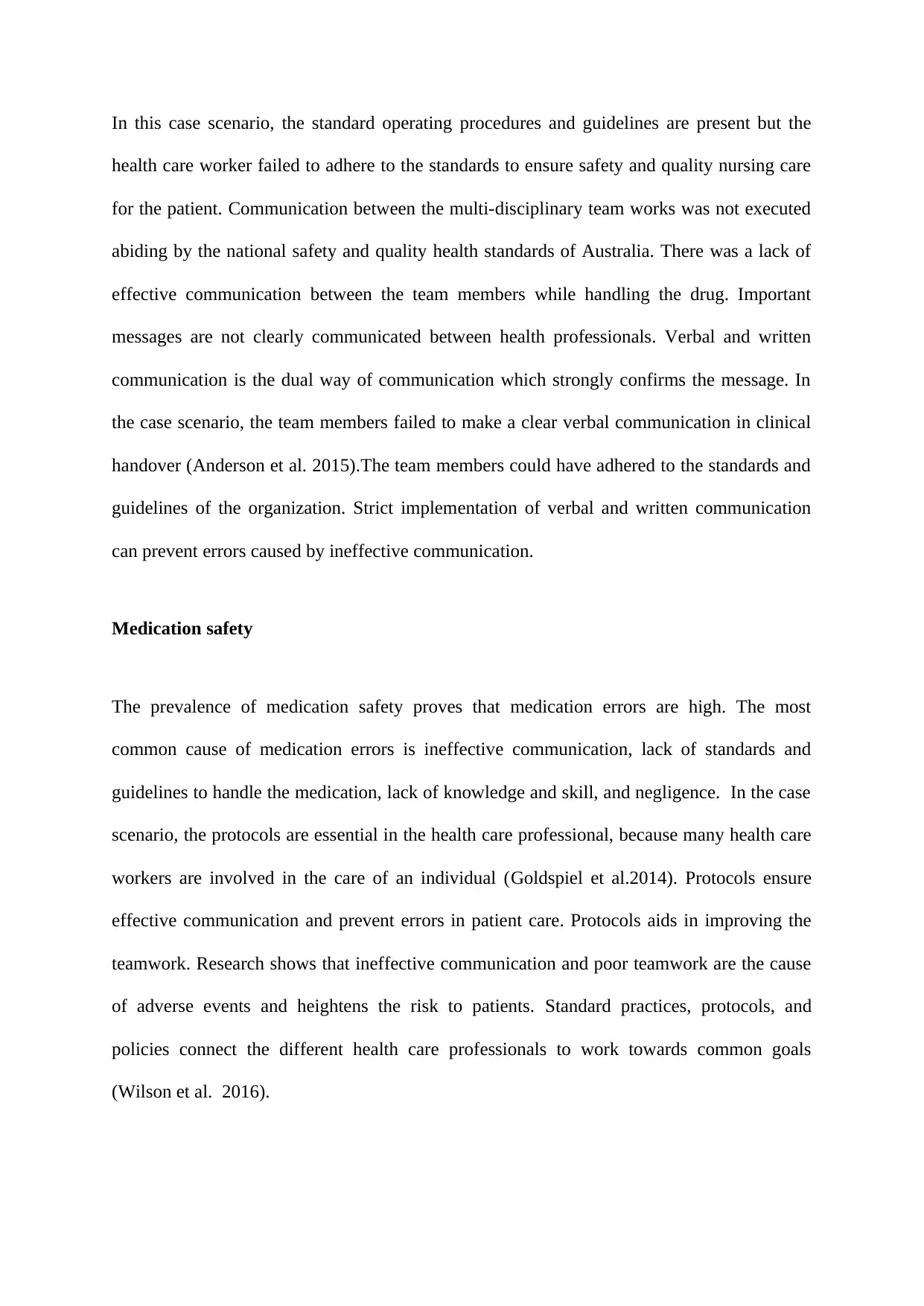
In this case scenario, the standard operating procedures and guidelines are present but the
health care worker failed to adhere to the standards to ensure safety and quality nursing care
for the patient. Communication between the multi-disciplinary team works was not executed
abiding by the national safety and quality health standards of Australia. There was a lack of
effective communication between the team members while handling the drug. Important
messages are not clearly communicated between health professionals. Verbal and written
communication is the dual way of communication which strongly confirms the message. In
the case scenario, the team members failed to make a clear verbal communication in clinical
handover (Anderson et al. 2015).The team members could have adhered to the standards and
guidelines of the organization. Strict implementation of verbal and written communication
can prevent errors caused by ineffective communication.
Medication safety
The prevalence of medication safety proves that medication errors are high. The most
common cause of medication errors is ineffective communication, lack of standards and
guidelines to handle the medication, lack of knowledge and skill, and negligence. In the case
scenario, the protocols are essential in the health care professional, because many health care
workers are involved in the care of an individual (Goldspiel et al.2014). Protocols ensure
effective communication and prevent errors in patient care. Protocols aids in improving the
teamwork. Research shows that ineffective communication and poor teamwork are the cause
of adverse events and heightens the risk to patients. Standard practices, protocols, and
policies connect the different health care professionals to work towards common goals
(Wilson et al. 2016).
health care worker failed to adhere to the standards to ensure safety and quality nursing care
for the patient. Communication between the multi-disciplinary team works was not executed
abiding by the national safety and quality health standards of Australia. There was a lack of
effective communication between the team members while handling the drug. Important
messages are not clearly communicated between health professionals. Verbal and written
communication is the dual way of communication which strongly confirms the message. In
the case scenario, the team members failed to make a clear verbal communication in clinical
handover (Anderson et al. 2015).The team members could have adhered to the standards and
guidelines of the organization. Strict implementation of verbal and written communication
can prevent errors caused by ineffective communication.
Medication safety
The prevalence of medication safety proves that medication errors are high. The most
common cause of medication errors is ineffective communication, lack of standards and
guidelines to handle the medication, lack of knowledge and skill, and negligence. In the case
scenario, the protocols are essential in the health care professional, because many health care
workers are involved in the care of an individual (Goldspiel et al.2014). Protocols ensure
effective communication and prevent errors in patient care. Protocols aids in improving the
teamwork. Research shows that ineffective communication and poor teamwork are the cause
of adverse events and heightens the risk to patients. Standard practices, protocols, and
policies connect the different health care professionals to work towards common goals
(Wilson et al. 2016).
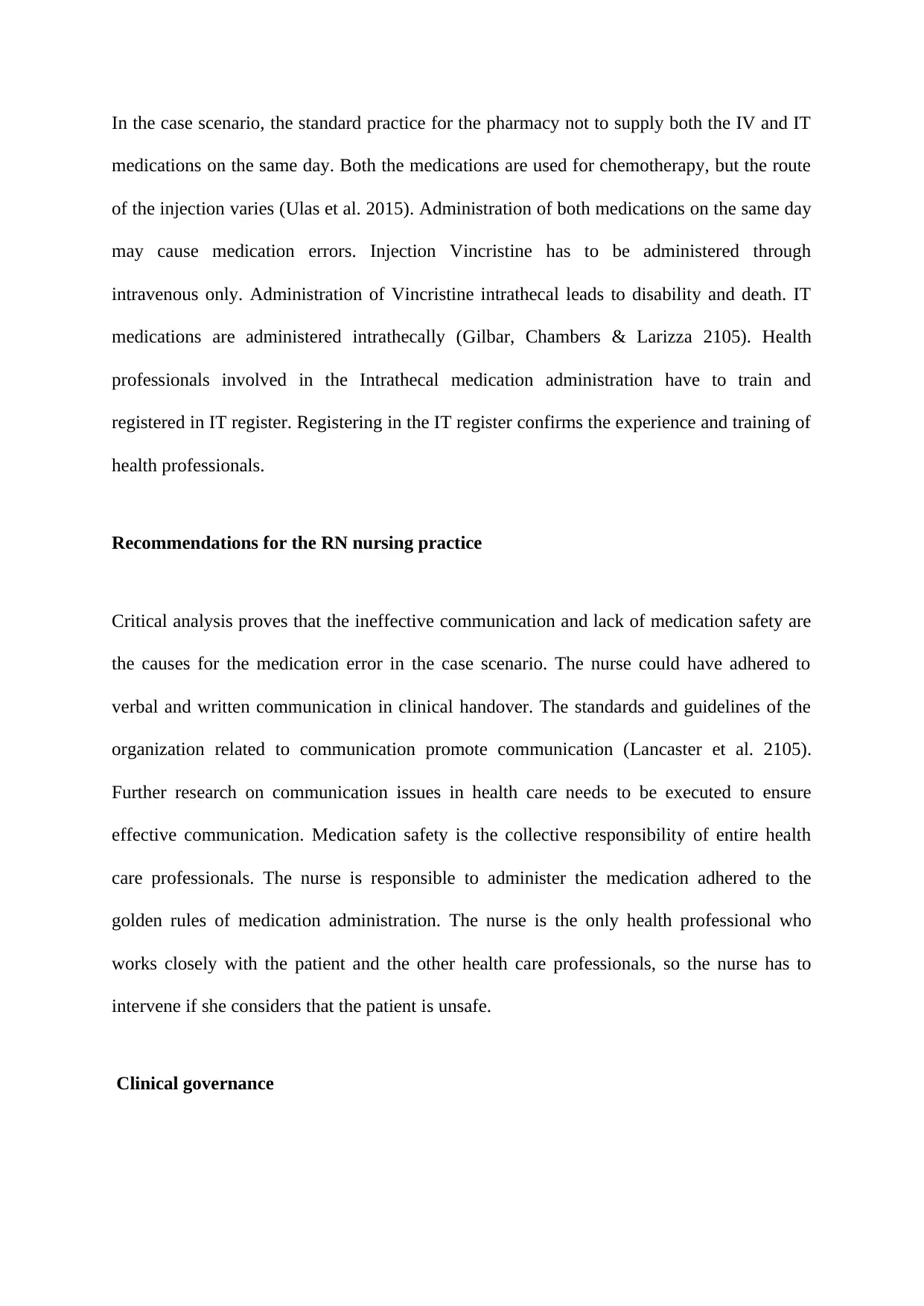
In the case scenario, the standard practice for the pharmacy not to supply both the IV and IT
medications on the same day. Both the medications are used for chemotherapy, but the route
of the injection varies (Ulas et al. 2015). Administration of both medications on the same day
may cause medication errors. Injection Vincristine has to be administered through
intravenous only. Administration of Vincristine intrathecal leads to disability and death. IT
medications are administered intrathecally (Gilbar, Chambers & Larizza 2105). Health
professionals involved in the Intrathecal medication administration have to train and
registered in IT register. Registering in the IT register confirms the experience and training of
health professionals.
Recommendations for the RN nursing practice
Critical analysis proves that the ineffective communication and lack of medication safety are
the causes for the medication error in the case scenario. The nurse could have adhered to
verbal and written communication in clinical handover. The standards and guidelines of the
organization related to communication promote communication (Lancaster et al. 2105).
Further research on communication issues in health care needs to be executed to ensure
effective communication. Medication safety is the collective responsibility of entire health
care professionals. The nurse is responsible to administer the medication adhered to the
golden rules of medication administration. The nurse is the only health professional who
works closely with the patient and the other health care professionals, so the nurse has to
intervene if she considers that the patient is unsafe.
Clinical governance
medications on the same day. Both the medications are used for chemotherapy, but the route
of the injection varies (Ulas et al. 2015). Administration of both medications on the same day
may cause medication errors. Injection Vincristine has to be administered through
intravenous only. Administration of Vincristine intrathecal leads to disability and death. IT
medications are administered intrathecally (Gilbar, Chambers & Larizza 2105). Health
professionals involved in the Intrathecal medication administration have to train and
registered in IT register. Registering in the IT register confirms the experience and training of
health professionals.
Recommendations for the RN nursing practice
Critical analysis proves that the ineffective communication and lack of medication safety are
the causes for the medication error in the case scenario. The nurse could have adhered to
verbal and written communication in clinical handover. The standards and guidelines of the
organization related to communication promote communication (Lancaster et al. 2105).
Further research on communication issues in health care needs to be executed to ensure
effective communication. Medication safety is the collective responsibility of entire health
care professionals. The nurse is responsible to administer the medication adhered to the
golden rules of medication administration. The nurse is the only health professional who
works closely with the patient and the other health care professionals, so the nurse has to
intervene if she considers that the patient is unsafe.
Clinical governance
⊘ This is a preview!⊘
Do you want full access?
Subscribe today to unlock all pages.

Trusted by 1+ million students worldwide
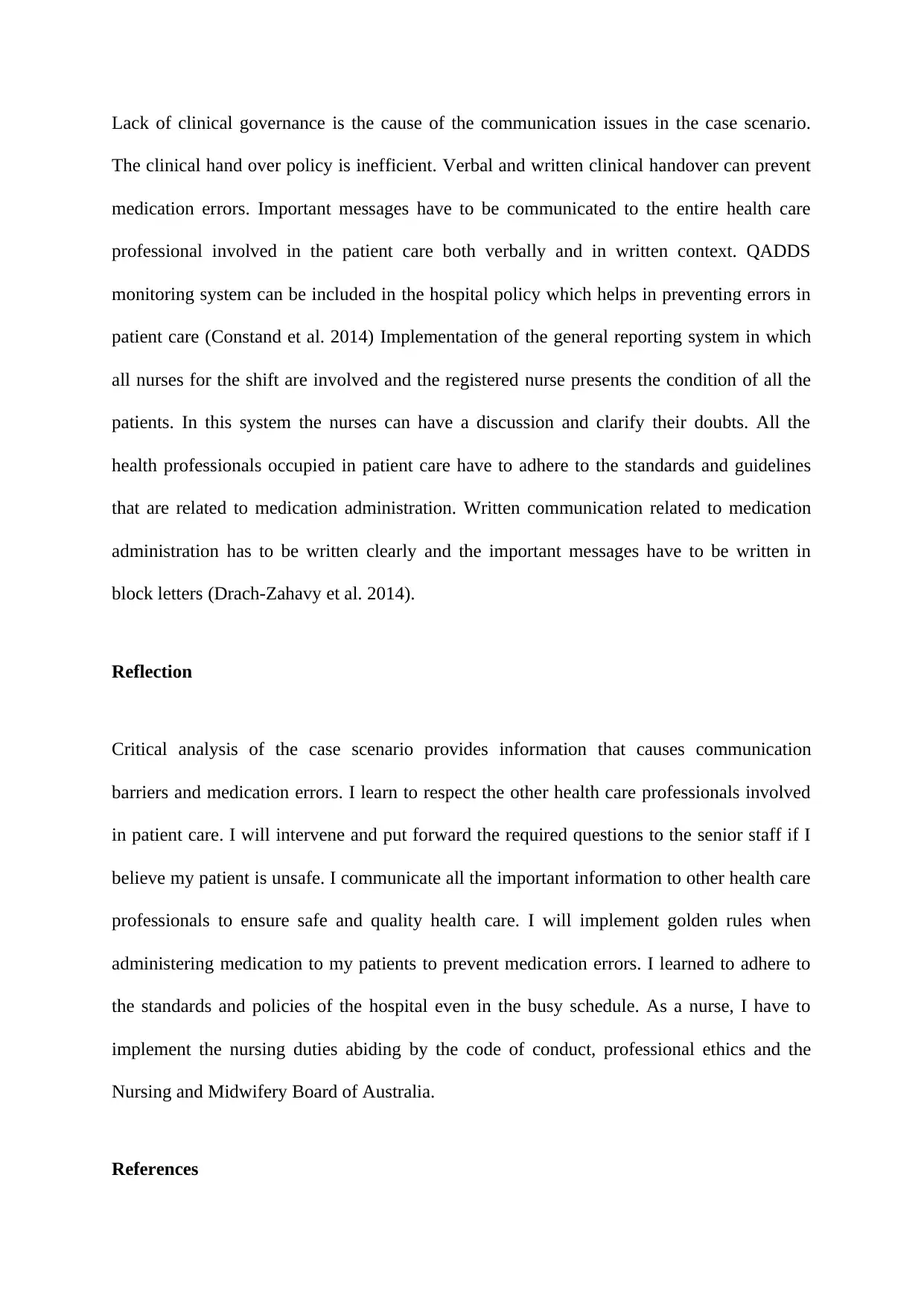
Lack of clinical governance is the cause of the communication issues in the case scenario.
The clinical hand over policy is inefficient. Verbal and written clinical handover can prevent
medication errors. Important messages have to be communicated to the entire health care
professional involved in the patient care both verbally and in written context. QADDS
monitoring system can be included in the hospital policy which helps in preventing errors in
patient care (Constand et al. 2014) Implementation of the general reporting system in which
all nurses for the shift are involved and the registered nurse presents the condition of all the
patients. In this system the nurses can have a discussion and clarify their doubts. All the
health professionals occupied in patient care have to adhere to the standards and guidelines
that are related to medication administration. Written communication related to medication
administration has to be written clearly and the important messages have to be written in
block letters (Drach-Zahavy et al. 2014).
Reflection
Critical analysis of the case scenario provides information that causes communication
barriers and medication errors. I learn to respect the other health care professionals involved
in patient care. I will intervene and put forward the required questions to the senior staff if I
believe my patient is unsafe. I communicate all the important information to other health care
professionals to ensure safe and quality health care. I will implement golden rules when
administering medication to my patients to prevent medication errors. I learned to adhere to
the standards and policies of the hospital even in the busy schedule. As a nurse, I have to
implement the nursing duties abiding by the code of conduct, professional ethics and the
Nursing and Midwifery Board of Australia.
References
The clinical hand over policy is inefficient. Verbal and written clinical handover can prevent
medication errors. Important messages have to be communicated to the entire health care
professional involved in the patient care both verbally and in written context. QADDS
monitoring system can be included in the hospital policy which helps in preventing errors in
patient care (Constand et al. 2014) Implementation of the general reporting system in which
all nurses for the shift are involved and the registered nurse presents the condition of all the
patients. In this system the nurses can have a discussion and clarify their doubts. All the
health professionals occupied in patient care have to adhere to the standards and guidelines
that are related to medication administration. Written communication related to medication
administration has to be written clearly and the important messages have to be written in
block letters (Drach-Zahavy et al. 2014).
Reflection
Critical analysis of the case scenario provides information that causes communication
barriers and medication errors. I learn to respect the other health care professionals involved
in patient care. I will intervene and put forward the required questions to the senior staff if I
believe my patient is unsafe. I communicate all the important information to other health care
professionals to ensure safe and quality health care. I will implement golden rules when
administering medication to my patients to prevent medication errors. I learned to adhere to
the standards and policies of the hospital even in the busy schedule. As a nurse, I have to
implement the nursing duties abiding by the code of conduct, professional ethics and the
Nursing and Midwifery Board of Australia.
References
Paraphrase This Document
Need a fresh take? Get an instant paraphrase of this document with our AI Paraphraser
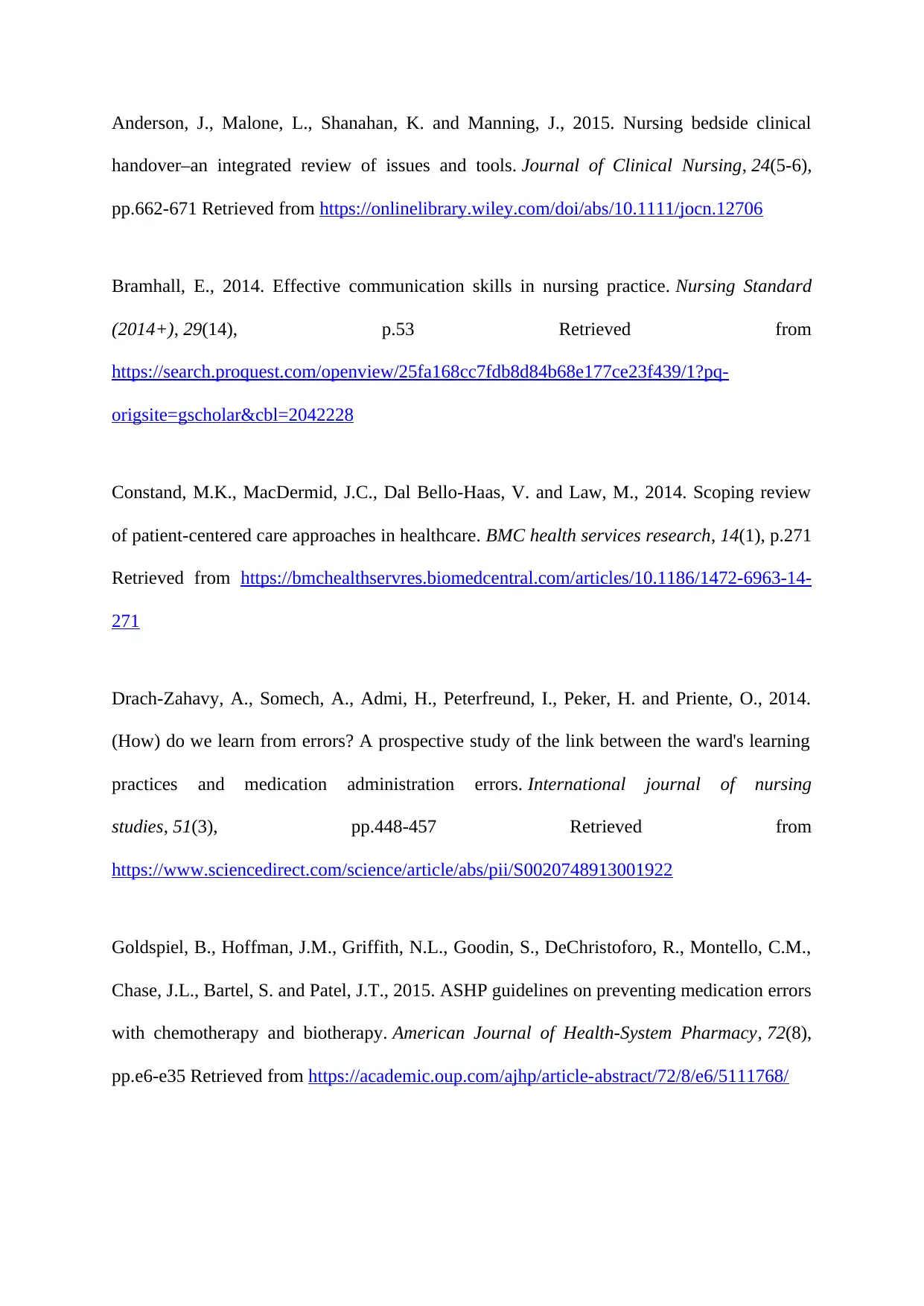
Anderson, J., Malone, L., Shanahan, K. and Manning, J., 2015. Nursing bedside clinical
handover–an integrated review of issues and tools. Journal of Clinical Nursing, 24(5-6),
pp.662-671 Retrieved from https://onlinelibrary.wiley.com/doi/abs/10.1111/jocn.12706
Bramhall, E., 2014. Effective communication skills in nursing practice. Nursing Standard
(2014+), 29(14), p.53 Retrieved from
https://search.proquest.com/openview/25fa168cc7fdb8d84b68e177ce23f439/1?pq-
origsite=gscholar&cbl=2042228
Constand, M.K., MacDermid, J.C., Dal Bello-Haas, V. and Law, M., 2014. Scoping review
of patient-centered care approaches in healthcare. BMC health services research, 14(1), p.271
Retrieved from https://bmchealthservres.biomedcentral.com/articles/10.1186/1472-6963-14-
271
Drach-Zahavy, A., Somech, A., Admi, H., Peterfreund, I., Peker, H. and Priente, O., 2014.
(How) do we learn from errors? A prospective study of the link between the ward's learning
practices and medication administration errors. International journal of nursing
studies, 51(3), pp.448-457 Retrieved from
https://www.sciencedirect.com/science/article/abs/pii/S0020748913001922
Goldspiel, B., Hoffman, J.M., Griffith, N.L., Goodin, S., DeChristoforo, R., Montello, C.M.,
Chase, J.L., Bartel, S. and Patel, J.T., 2015. ASHP guidelines on preventing medication errors
with chemotherapy and biotherapy. American Journal of Health-System Pharmacy, 72(8),
pp.e6-e35 Retrieved from https://academic.oup.com/ajhp/article-abstract/72/8/e6/5111768/
handover–an integrated review of issues and tools. Journal of Clinical Nursing, 24(5-6),
pp.662-671 Retrieved from https://onlinelibrary.wiley.com/doi/abs/10.1111/jocn.12706
Bramhall, E., 2014. Effective communication skills in nursing practice. Nursing Standard
(2014+), 29(14), p.53 Retrieved from
https://search.proquest.com/openview/25fa168cc7fdb8d84b68e177ce23f439/1?pq-
origsite=gscholar&cbl=2042228
Constand, M.K., MacDermid, J.C., Dal Bello-Haas, V. and Law, M., 2014. Scoping review
of patient-centered care approaches in healthcare. BMC health services research, 14(1), p.271
Retrieved from https://bmchealthservres.biomedcentral.com/articles/10.1186/1472-6963-14-
271
Drach-Zahavy, A., Somech, A., Admi, H., Peterfreund, I., Peker, H. and Priente, O., 2014.
(How) do we learn from errors? A prospective study of the link between the ward's learning
practices and medication administration errors. International journal of nursing
studies, 51(3), pp.448-457 Retrieved from
https://www.sciencedirect.com/science/article/abs/pii/S0020748913001922
Goldspiel, B., Hoffman, J.M., Griffith, N.L., Goodin, S., DeChristoforo, R., Montello, C.M.,
Chase, J.L., Bartel, S. and Patel, J.T., 2015. ASHP guidelines on preventing medication errors
with chemotherapy and biotherapy. American Journal of Health-System Pharmacy, 72(8),
pp.e6-e35 Retrieved from https://academic.oup.com/ajhp/article-abstract/72/8/e6/5111768/
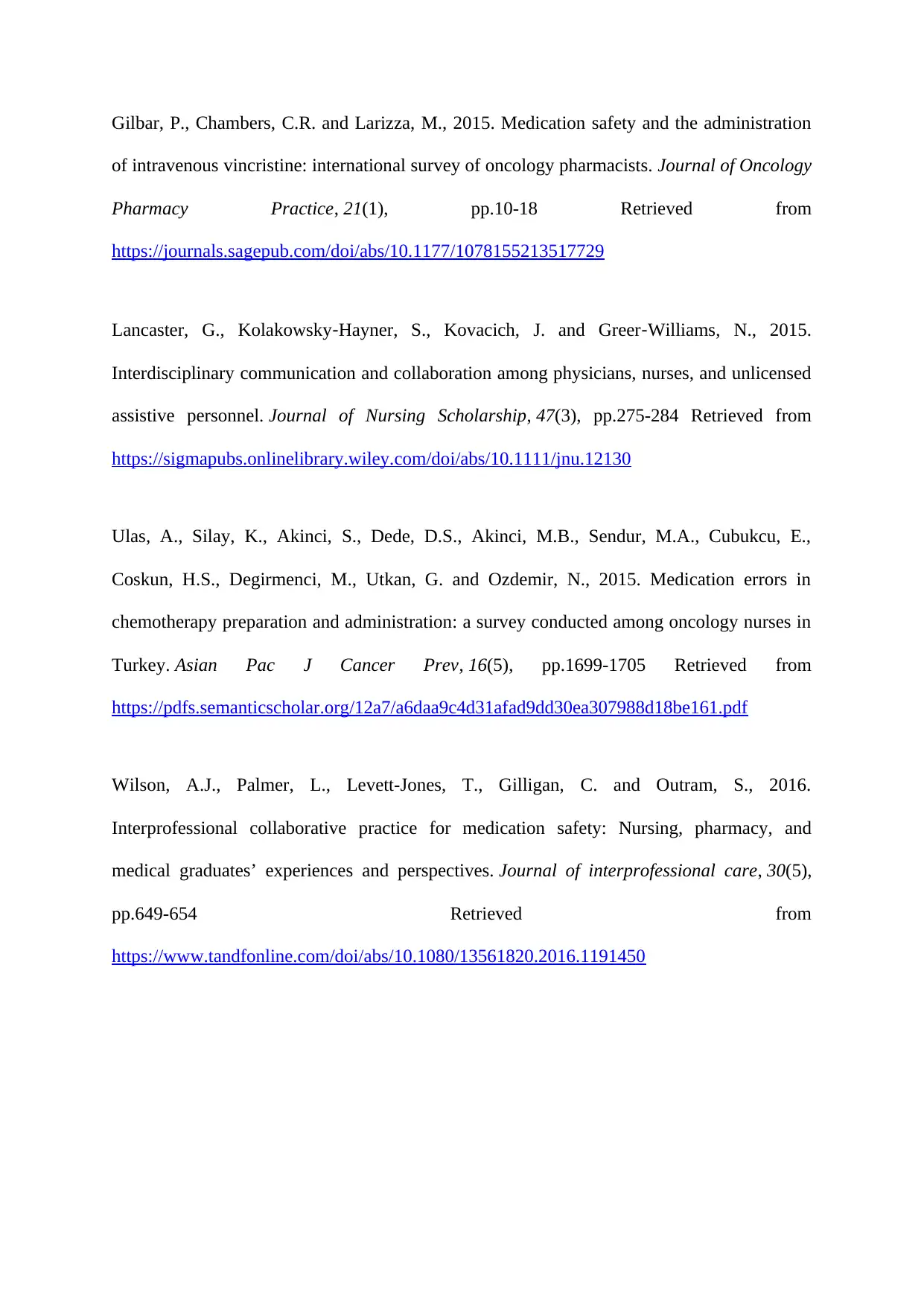
Gilbar, P., Chambers, C.R. and Larizza, M., 2015. Medication safety and the administration
of intravenous vincristine: international survey of oncology pharmacists. Journal of Oncology
Pharmacy Practice, 21(1), pp.10-18 Retrieved from
https://journals.sagepub.com/doi/abs/10.1177/1078155213517729
Lancaster, G., Kolakowsky‐Hayner, S., Kovacich, J. and Greer‐Williams, N., 2015.
Interdisciplinary communication and collaboration among physicians, nurses, and unlicensed
assistive personnel. Journal of Nursing Scholarship, 47(3), pp.275-284 Retrieved from
https://sigmapubs.onlinelibrary.wiley.com/doi/abs/10.1111/jnu.12130
Ulas, A., Silay, K., Akinci, S., Dede, D.S., Akinci, M.B., Sendur, M.A., Cubukcu, E.,
Coskun, H.S., Degirmenci, M., Utkan, G. and Ozdemir, N., 2015. Medication errors in
chemotherapy preparation and administration: a survey conducted among oncology nurses in
Turkey. Asian Pac J Cancer Prev, 16(5), pp.1699-1705 Retrieved from
https://pdfs.semanticscholar.org/12a7/a6daa9c4d31afad9dd30ea307988d18be161.pdf
Wilson, A.J., Palmer, L., Levett-Jones, T., Gilligan, C. and Outram, S., 2016.
Interprofessional collaborative practice for medication safety: Nursing, pharmacy, and
medical graduates’ experiences and perspectives. Journal of interprofessional care, 30(5),
pp.649-654 Retrieved from
https://www.tandfonline.com/doi/abs/10.1080/13561820.2016.1191450
of intravenous vincristine: international survey of oncology pharmacists. Journal of Oncology
Pharmacy Practice, 21(1), pp.10-18 Retrieved from
https://journals.sagepub.com/doi/abs/10.1177/1078155213517729
Lancaster, G., Kolakowsky‐Hayner, S., Kovacich, J. and Greer‐Williams, N., 2015.
Interdisciplinary communication and collaboration among physicians, nurses, and unlicensed
assistive personnel. Journal of Nursing Scholarship, 47(3), pp.275-284 Retrieved from
https://sigmapubs.onlinelibrary.wiley.com/doi/abs/10.1111/jnu.12130
Ulas, A., Silay, K., Akinci, S., Dede, D.S., Akinci, M.B., Sendur, M.A., Cubukcu, E.,
Coskun, H.S., Degirmenci, M., Utkan, G. and Ozdemir, N., 2015. Medication errors in
chemotherapy preparation and administration: a survey conducted among oncology nurses in
Turkey. Asian Pac J Cancer Prev, 16(5), pp.1699-1705 Retrieved from
https://pdfs.semanticscholar.org/12a7/a6daa9c4d31afad9dd30ea307988d18be161.pdf
Wilson, A.J., Palmer, L., Levett-Jones, T., Gilligan, C. and Outram, S., 2016.
Interprofessional collaborative practice for medication safety: Nursing, pharmacy, and
medical graduates’ experiences and perspectives. Journal of interprofessional care, 30(5),
pp.649-654 Retrieved from
https://www.tandfonline.com/doi/abs/10.1080/13561820.2016.1191450
⊘ This is a preview!⊘
Do you want full access?
Subscribe today to unlock all pages.

Trusted by 1+ million students worldwide

1 out of 7
Related Documents
Your All-in-One AI-Powered Toolkit for Academic Success.
+13062052269
info@desklib.com
Available 24*7 on WhatsApp / Email
![[object Object]](/_next/static/media/star-bottom.7253800d.svg)
Unlock your academic potential
Copyright © 2020–2025 A2Z Services. All Rights Reserved. Developed and managed by ZUCOL.





